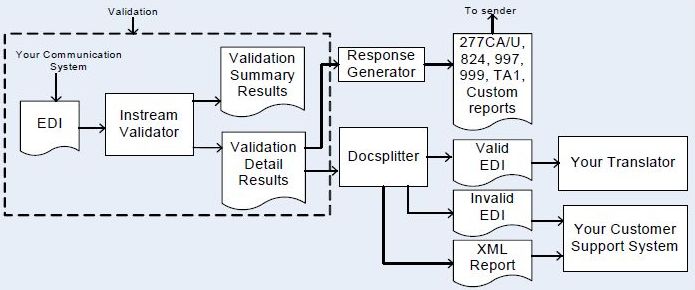TIBCO Foresight Overview
This document focuses on the transaction validation, response generation, document splitting, translation and other functions provided by TIBCO Foresight products as part of the EDI Plug-in.
Transaction Validation with Instream
Before using this document, familiarize yourself with Electronic Data Interchange (EDI). See Electronic Data Interchange for more information.
TIBCO Foresight products benefit customers by connecting partners, validating transactions, reducing administrative inefficiencies and addressing mandates such as HIPAA 5010. The TIBCO Foresight family of EDI management solutions allows organizations to trade electronic transactions with commonly-used formats (EDI, XML, and proprietary Flat File) and standards (HIPAA, X12, EDIFACT, and so on).
Instream ensures the compliance of inbound and outbound data using the fastest and most thorough transaction validation engine.
You can use Instream to automate transaction flow throughout your organization and validate transactions according to industry standards, organizational guidelines, and specific business rules.
Instream is designed to be highly configurable, with several components that work together. The following figure shows Instream, Response Generator, and Document Splitter working together to process inbound EDI.
Reference
See Instream Validation Technical Manual PDF document for more information about the Instream validation function.
Response documents (also called acknowledgments) are used to give feedback to the sender of a transaction on the status of the acceptance of the transaction by its recipient. After validation, the Response Generator function can be used to generate a response document for transmission to the sender.
References
- See Response Documents (Acknowledgments) for more information on the response documents available through Response Generator.
- See Response Generator Technical Manual PDF document for more information about the response generation function.
After validation, the Document Splitter function can be used to split data into two types: valid and invalid. For example, Docsplitter can sift out invalid claims in an 837 so that you can process the valid ones and notify the sender of the invalid ones.
Reference
See Document Splitter Technical Manual PDF document for more information about the document splitting function.
After validation, Data Swapping can be used to substitute values in EDI data.
Reference
See Dataswapper PDF document for more information about the data swapping function.
Translator is a specialized, high-speed transformation engine that enables the mass conversion of transaction files based on pre-built or custom maps, providing direct translation to and from EDI, XML, and Flat File formats with no interim staging required.
You can use Translator to translate the input data in one format to a new file in another format. The following figure shows the translation workflow.
Reference
See Translator PDF document for more information about the translation function.


